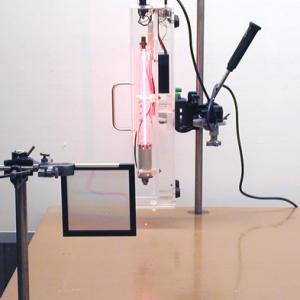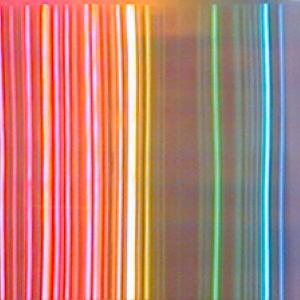College of Liberal Arts & Sciences
7G30.10 - Wavelengths of a He-Ne Laser
Set the laser so that the tube is standing straight up and down. Observe the emission lines of the tube with the grating. A variety of emission lines should be present in addition to the 632.8 nanometer wavelength emitted by the laser. In particular note the 543.5 nanometer green line. (There should also be an infrared line at 1150 nm).
The approximate mixture of gases in the tube should be 15 % He and 85 % Ne.
- David W. Steinhaus, "Measurements on the He-Ne Laser Lines Near 633 nm", AJP, Vol. 51, #9, Sep. 1983, p. 824.
- C. Wong, T. Webb, and C. Londono, "Observation of Wavelength Drift of a He-Ne Laser", AJP, Vol. 48, #4, April 1980, p. 306.
- J. L. Rapier, H. H. Heimple, and A. L. Schawlow, "Spontaneous Emission from a Helium-Neon Laser as a Convenient Wavelength Standard", AJP, Vol. 35, #9, Sept. 1967, p. 890.
- John M. Dudley and Goëry Genty, "Supercontinuum Light", Physics Today, Vol. 66, #7, July 2013, p. 29.
- Frank DeFreitas, Alan Rhody, and Steve Michael, "Continuous Wave Gas Lasers", Shoebox Holography - A Step-By-Step Guide To Making Holograms Using Inexpensive Semiconductor Diode Lasers, pp. 39.
- Gordon McComb, "He-Ne Colors", Lasers, Ray Guns, & Light Cannons, p. 70.
- T. D. Rossing, C. J. Chiaverina, Light Science, Physics and Visual Arts, p. 139.
Disclaimer: These demonstrations are provided only for illustrative use by persons affiliated with The University of Iowa and only under the direction of a trained instructor or physicist. The University of Iowa is not responsible for demonstrations performed by those using their own equipment or who choose to use this reference material for their own purpose. The demonstrations included here are within the public domain and can be found in materials contained in libraries, bookstores, and through electronic sources. Performing all or any portion of any of these demonstrations, with or without revisions not depicted here entails inherent risks. These risks include, without limitation, bodily injury (and possibly death), including risks to health that may be temporary or permanent and that may exacerbate a pre-existing medical condition; and property loss or damage. Anyone performing any part of these demonstrations, even with revisions, knowingly and voluntarily assumes all risks associated with them.

